Since coming to Japan and acquiring my Olympus E-P1 I’ve been getting into photography in a more serious way than ever before. I’ve been dabbling since I was 16, but more recently learning in leaps and bounds with the help of one professional photographer, Jason Collin.
All pictures below are examples of Jason’s Photography. See more on his website!
It was just summer last year when I finally got my first ‘real’ camera. I decided to forego the bulk of a regular DSLR for the power and compactness of the E-P1 – a camera from the new micro 4/3 format that Olympus and Panasonic are pioneering. Basically a DSLR in the body of a compact. For sure, there are areas such as high speed photography where a DSLR is still unmatched, but for the majority of my photography right now, I can do pretty much everything I want to and just enjoy the process of making pictures.
But getting a more powerful camera has helped me realise that there really is a lot more to good photography than just having the right tools. Although undoubtedly the technical understanding of a camera is very important to taking good pictures, it seems much more to be about developing an artistic sense and developing an eye for composition. Not just that, but picture making also happens in the digital dark room afterwards. And this is one of the biggest revelations I have had thanks to Jason.
Jason Collin is a professional photographer specialising in candids and portaits and currently living and working in Saint Petersburg with his wife Aya. I first ‘met’ him through my wanderings into the Japan blogging world and was quickly enamoured with his images and also his interest in haikyo, the ruins of Japan. Unfortunately I never had a chance to meet him in real life before he returned to Florida, but the networking nature of the internet meant he was still within reach.
I asked for his advice on my latest haikyo post and he offered me his honest and enlightening thoughts about my images in an email to me. It was humbling, perhaps even shocking for me to be told that, despite my best effort to date, my images were still not at a high enough standard. Still too blurry (but to my eyes they were sharp!). Too underexposed (I thought it added character!)
But I was doing something right, he said. The compositions were not bad and the images were eye catching. But I needed to venture into post-processing work to bring out the best in them. Jason offered to touch up my images for me and show me what he could do. I was amazed, and for lack of a better expression, converted. No more excuse like ‘messing around in Photoshop is too much effort!’. After trying some of Jason’s suggestions, I have really started to improve on the images, and he has also given me great advice to improve shooting technique in order to improve the raw data I capture in the field. (Because no amount of work in the digital dark room can save an image that is bad from the start!)
Granted, I still have a lot to learn to get the most out of my camera and post-processing tools, and of course, to develop that photographer’s eye for composition. But it’s a fun process and I’m loving learning more and more every day. So a big thanks to Jason for all his help recently and, naturally, a big recommendation for him if you have any photography-related questions or commissions!
You can find Jason’s professional website here at Jason Collin Photography where you can contact him for work and advice. He teaches photography in the Florida area and is also on Twitter and Flickr (with all his best work!). Go and give him a follow.
All images in this post are copyright of Jason. None are mine! (Though I hope somebody to be able to produce stuff like this!)














I kept meaning to put your edits up but got tied up with other things. Will put them up on this site sometime soon so people can see the difference. :)
Hi Tiffany….ok, I will actually be posting on my site another person's haikyo photograph I re-edited in the near future, I'll be sure and comment back here with a link.
Of if Gak has the re-edits and originals of his shots he can post them here too?
Strong editing skills are KEY to making great photographs. Everyone says get it right in the camera, and that works pretty well for outdoor shooting of sports and wildlife, but everything else, strong editing skills can often save or much improve your shots. Just being able to clone out shadows, stray objects, makes a huge difference.
The before and after shot I'll put on my site of my own work, a kid put a shadow over his dad's face, which would have ruined the shot if not for being able to simply remove that shadow.
Thanks Jason! I was actually thinking of the photos that Gakuranman mentioned you editing for him ~ “Jason offered to touch up my images for me and show me what he could do. I was amazed, and for lack of a better expression, converted.”
It would be great to see what kind of improvements you made to his pictures. I thought maybe he could post some of them.
Yes, I have upgraded to Aperture 3 and only used its brushes once to lighten part of an image. Basically Aperture 3 has not changed my workflow much, yet, save for slowing it way down because it takes much longer to launch the Nik plugins in Aperture 3 and Aperture's own adjustment sliders, which used to show instant changes in Ap 2, now have a nearly intolerable couple second lag in Ap 3. May have to upgrade to Snow Leopard after all, but then Nik plugins are not 64 bit yet, so would still need to launch Ap 3 in 32-bit mode. Ap 3 is dog slow, and before the 0.1 update was crazy buggy. Still has its quirks and freezes though.
thx Jason, I recently upgraded to Aperture 3. Maybe a little bit off topic, but would you recommend Nik Color efex pro 3 considering the new presets and brushes in Aperture 3?
Tiffany, these particular shots Gak selected of mine actually have very little editing to them. The lead temple shot was made during the golden hour, so required very little editing beyond a bit of color correction.
The girl smiling is a pure candid street photography shot, just a bit of sharpening added.
The 4 kimonos, just minor exposure and color correction.
The leaf with bokeh shot is basically straight out of the camera (Nikon D80 then with Nikkor 50mm 1.8D lens, as cheap as a lens gets)
The Mt. Fuji shot is not edited much either, just a little vignetting fixing, as the Nikkor 18-200mm lens I shot it with suffered from that problem, I long ago sold it due to that problem and other issues with it.
Here is a shot that I did do a substantial amount of editing on, and in my view saved a shot that would have been a fail:
http://jasoncollinphotography.com/blog/2009/11/…
Silver Efex Pro did most of the work, but I did clone out shadows in Photoshop CS4.
David, for processing my RAW images I just import them into Aperture 3 and his that app's specific RAW profile for my specific camera (Nikon D300). That's it. No mess, no fuss. Then from there I follow my usual editing work flow, which relies heavily on Nik Color Efex Pro 3.
Thanks very much for this post Gak, I am flattered. The photos you chose are also some of my own personal most favorites, and some of the few images of my own I have hanging in my own home (lead shot and Mt. Fuji shot).
I am glad to be able offer you candid advice on your own photographs. The best way to get better is to show your own work, and show it often. I run my photographs by much more experienced photographers on a monthly basis to get their feedback on which images of mine work better than others, although I have learned how to become a “ruthless editor” of my own work. It might be easy to fall into love with one's own shots and think they are all great, but really out of any given day of shooting, my goal is to get one shot out of hundreds that I think is at least ok and meet my goal for that day's shooting.
I will try and share more of what I have learned on my own and from other photographers as I can.
Thanks again Gak and one thing I am very impressed with is your coding skills. Your site looks very professional.
I was going to ask that as well ~ I'd love to see some of the before & afters that he altered.
Could you share some of the touch up images and the raw photo techniques?